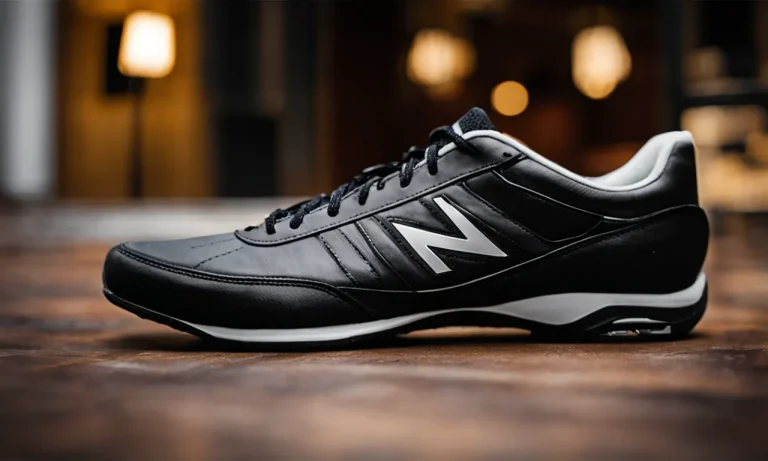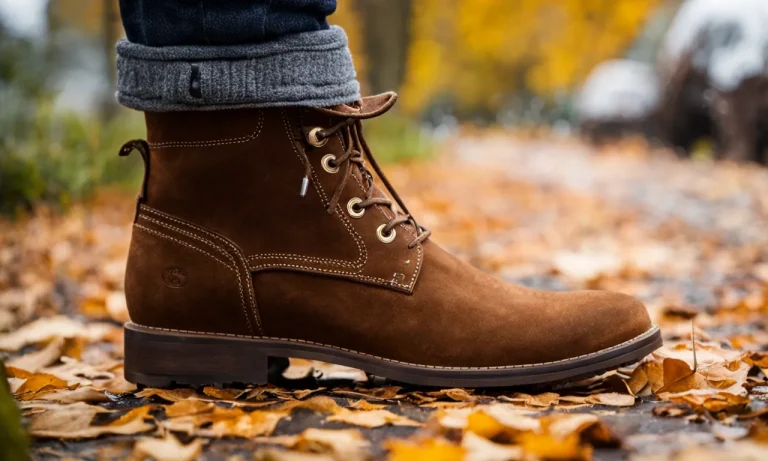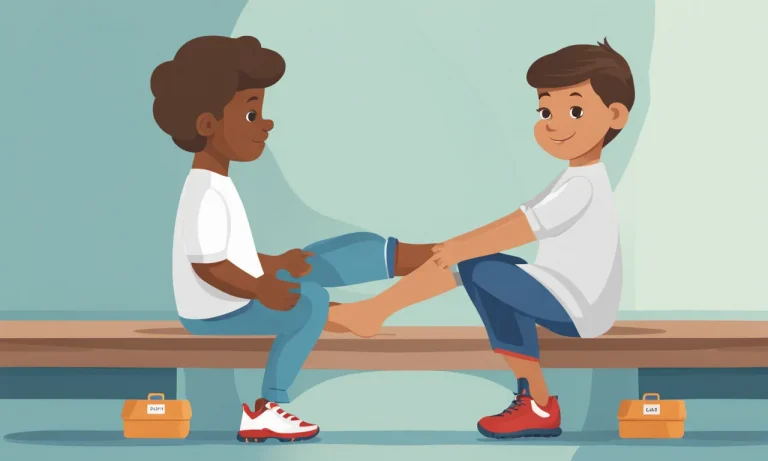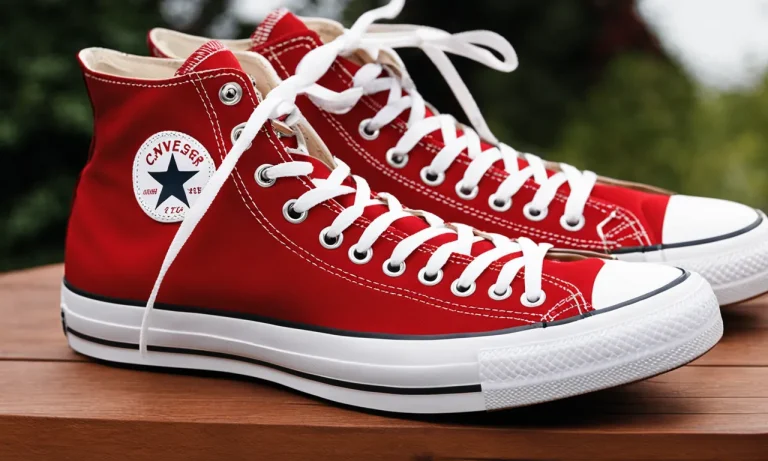If you have ever slipped on a pair of sneakers or boots and noticed the tongue sliding over to one side, you’re not alone. The pesky tongue that refuses to stay centered can be annoying and uncomfortable. But why does it happen in the first place?
If you’re short on time, here’s a quick answer to your question: The tongue of a shoe tends to slide to the side due to pressure from your foot and ankle as you walk or run. The shape of your foot, flexibility of the shoe materials, fit of the shoe and the position of your foot inside can all contribute to an off-center tongue.
Causes of a Shifting Tongue
Foot Shape and Size
The shape and size of your feet can play a role in causing the tongue of your shoe to shift to the side. Everyone’s feet are unique, and some individuals may have feet that are wider or narrower than average.
If your shoes are not designed to accommodate the specific shape and size of your feet, the tongue may not sit properly and can easily shift to one side. It is important to find shoes that provide a snug fit and have enough room for your feet to avoid this issue.
Shoe Fit
The fit of your shoes is crucial in preventing the tongue from shifting. If your shoes are too loose or too tight, the tongue may not stay centered and can move to the side during movement. When purchasing shoes, it is important to ensure that they fit properly and provide enough support for your feet.
Consider trying different sizes or widths to find the best fit for you.
Shoe Construction and Materials
The construction and materials used in the shoes can also contribute to the shifting of the tongue. Some shoes may have a design or stitching that causes the tongue to be less stable and more prone to moving to the side.
Additionally, certain materials may be more slippery, making it easier for the tongue to slide. Choosing shoes with a sturdy construction and materials that grip the tongue can help prevent this issue.
Lace Tightness
The tightness of your shoelaces can impact the movement of the tongue. If your laces are too loose, the tongue may not be held in place and can easily shift to the side. On the other hand, if your laces are too tight, they may cause the tongue to be pushed to one side.
Finding the right balance in lace tightness can help keep the tongue centered and prevent it from moving to the side.
Movement and Wear
Regular movement and wear can also contribute to the shifting of the tongue over time. As you walk or engage in various activities, the tongue may naturally shift due to the repetitive motion and pressure.
Additionally, as shoes age and wear out, the stability of the tongue may decrease, making it more prone to shifting. Regularly replacing worn-out shoes and maintaining proper shoe care can help prevent this issue.
How to Keep the Tongue in Place
Do you often find the tongue of your shoe sliding to the side, causing discomfort and annoyance? Don’t worry, you’re not alone! Many people face this issue, but there are several simple solutions to help keep the tongue in place.
Choose the Right Size and Width
One of the main reasons why the tongue of your shoe may go to the side is because the shoe doesn’t fit properly. When buying new shoes, make sure to choose the right size and width that perfectly matches the shape of your foot.
Ill-fitting shoes can cause the tongue to move around, leading to discomfort. If you’re unsure about your shoe size, it’s always a good idea to get your feet measured by a professional.
Adjust Lace Tightness
Another factor that can affect the positioning of the tongue is the tightness of your shoelaces. If your laces are too loose, the tongue is more likely to slide to the side. On the other hand, if they are too tight, they can put excessive pressure on the tongue, causing discomfort.
Find a balance by adjusting the tightness of your laces to keep the tongue in place without compromising on comfort.
Use Tongue Pads or Stays
If you’re still having trouble with the tongue slipping to the side, consider using tongue pads or stays. These are adhesive pads or inserts that can be attached to the tongue of your shoe to provide extra support and prevent it from moving around.
Tongue pads are particularly helpful for shoes with a wide opening or those that have a tendency to cause the tongue to shift.
Break in the Shoes
Sometimes, the issue with the tongue going to the side may be temporary and caused by new shoes that haven’t been properly broken in yet. Breaking in your shoes involves wearing them gradually over time to allow them to adjust to the shape of your feet.
As you wear them more frequently, the materials will start to soften and mold to your foot, reducing the likelihood of the tongue slipping to the side.
Wear Higher Socks or Ankle Braces
If you’re engaging in activities that involve a lot of movement, such as running or playing sports, wearing higher socks or ankle braces can help keep the tongue in place. These provide additional support and create a barrier that prevents the tongue from shifting to the side.
Additionally, higher socks or ankle braces can also help cushion your feet and reduce the risk of blisters or discomfort.
By following these simple tips, you can keep the tongue of your shoe in place and enjoy a more comfortable and secure fit. Remember, finding the right shoe size, adjusting lace tightness, using tongue pads or stays, breaking in your shoes, and wearing higher socks or ankle braces can make a significant difference in preventing the tongue from sliding to the side.
When to See a Podiatrist
If you’ve noticed that the tongue of your shoe tends to go to the side, it may be a sign that you need to see a podiatrist. While it may seem like a minor inconvenience, this issue can actually indicate an underlying problem with your feet or legs.
Here are a few situations where it’s important to seek professional help:
Persistent Discomfort or Pain
If you experience persistent discomfort or pain when wearing shoes, it’s time to consult a podiatrist. This could be a sign of an alignment issue or a structural problem with your feet. A podiatrist can evaluate your condition and recommend appropriate treatment options to alleviate your discomfort.
Leg Length Discrepancy
A leg length discrepancy can cause the tongue of your shoe to go to the side. This condition occurs when one leg is longer than the other, which can lead to an uneven distribution of weight and pressure on your feet.
A podiatrist can assess your leg length and provide solutions such as shoe lifts or orthotics to help correct the imbalance.
Foot Conditions Like Bunions
Bunions are a common foot condition that can cause the tongue of your shoe to shift to the side. These bony bumps develop at the base of the big toe and can cause discomfort and difficulty finding properly fitting shoes.
A podiatrist can offer treatment options such as padding, orthotics, or in severe cases, surgical intervention.
History of Injuries
If you have a history of foot or ankle injuries, it’s important to see a podiatrist if you notice any issues with the tongue of your shoe. Previous injuries can lead to imbalances or instability in your feet, which can cause the tongue to shift.
A podiatrist can assess your situation, recommend appropriate treatments, and help prevent further complications.
Remember, it’s always better to be safe than sorry when it comes to your foot health. Consulting a podiatrist can help identify and address any underlying issues that may be causing the tongue of your shoe to go to the side, ensuring your feet stay comfortable and healthy.
Conclusion
A shifting tongue that slides to the side in shoes is often just an annoyance, but can sometimes indicate an underlying fit issue or foot problem. Paying attention to sizing, lacing, fit adjustments and frequent movement patterns can help keep the tongue in place.
If discomfort persists, it’s a good idea to see a podiatrist to rule out any alignment or health issues. With a few tweaks and professional help if needed, you can get back to comfortable walking and running in shoes with a tongue that stays centered.






